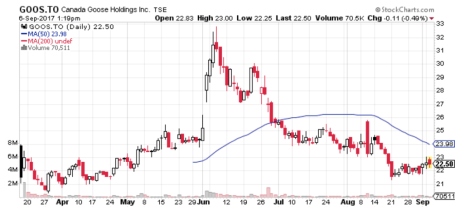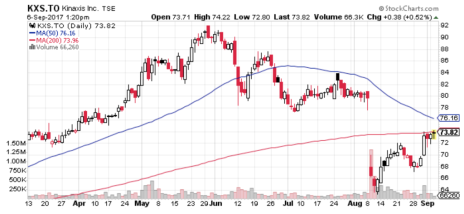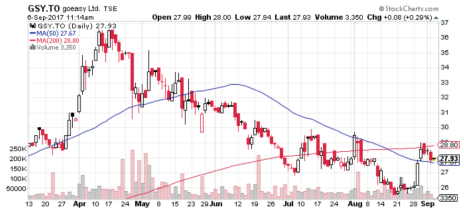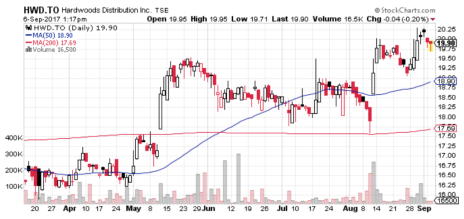Canada is Growing Faster than the U.S.!
One of the generally accepted wisdoms over the past couple of years has been that the U.S. stock market is where the action is. But relative performance of ex-U.S. markets is showing that’s no longer the case. There are market-beating returns available to those investors willing to step abroad. And one of the easiest steps to take is just over the border with our neighbor to the north, Canada. For the modestly adventurous investor, I think there are quite a few Canadian small-cap stocks worth a look right now.
Buying Canadian stocks is a relatively easy pitch to U.S. investors, in my view, especially to those that live within a day’s drive of the border. It’s a stable, developed economy and an established trading partner. While there are certainly a lot of differences between the U.S. and Canada, the country is friendly both for travel and investment, and most Canadian small-cap stocks have considerable exposure to the U.S. economy.
Growth in the Canadian economy provides a pleasant backdrop for investing as well. In the first quarter of 2017, Canadian GDP grew by 2.3%, then accelerated to 3.7% in the second quarter. Both rates compare favorably to economic growth in the U.S. (up 1.3% in Q1 2017 and 3.0% in Q2 2017).
[text_ad]
A lot of investors head to the Vancouver stock exchange for Canadian small-cap stocks. But these days, I go to the Toronto stock exchange. This exchange tends to list more mature companies and there are far more options in the sectors I follow, which are predominantly technology, consumer and health care.
4 Canadian Small-Cap Stocks that are Beating the Market
Here’s a brief overview of four Canadian small-cap stocks from different sectors that are beating the U.S. market right now. All figures are in USD, unless otherwise stated.
Canadian Small-Cap Stock #1: Canada Goose Holdings (GOOS, GOOS.TO)
It’s a bit of a stretch to call Canada Goose a Canadian small-cap stock given its current market cap is nearly $2 billion, that it also trades on the NYSE, and that the U.S. and Europe represent big growth markets. But its history is undeniably Canadian, it’s still based in Toronto, and I’m stretching a little here to accommodate the premium outwear company given it has such an interesting story.
It begins in 1957 with a Polish immigrant making cold-weather workwear out of a Toronto warehouse, then branching out to Europe and establishing a loyal customer base of dog sledders, arctic researchers, petroleum engineers and other people who frequently found themselves exposed to the harshest environments.
Fast forward about 50 years and you begin to find celebrities wearing the company’s jackets, which, for some models, retail for $1,000, or more. Then Kate Upton was featured on the cover of the 2013 Sports Illustrated Swimsuit Edition wearing a white Canada Goose jacket and things really took off. The clothing, which is apparently extremely well made, became as much a status symbol as a way to stay warm.
Revenue in 2015 reached C$291 million, with 89% coming from the wholesale channel and 11% from direct-to-consumer (DTC). In 2016, revenue grew by 39%, with DTC sales exploding by 250%. Expansion of the DTC channel is one of the reasons analysts love the stock given that it should help smooth out sales (Q2 and Q3 are currently the big quarters), while also boosting profit margins. The company has recently opened its first two retail stores (in Toronto and New York City), as well as two of seven planned e-commerce sites (in France and the U.K.). Management is also launching Knitwear in stores to further balance sales throughout the year.
Revenue growth should be in the 20% to 25% range this year and next, with EPS growth in the 25% to 30% range, depending on the sales mix. The company went public in March, and after an initial surge, shares have come down following a secondary offering by insiders in June.
Canadian Small-Cap Stock #2: Kinaxis (KXS.TO, KXSCF)
Many cloud-based software providers in the U.S. have enjoyed remarkable success in recent years, but the trend is far from a U.S.-only phenomenon. The world is moving to the cloud, and Kinaxis makes an excellent supply chain solution for global companies. It’s main software offering is called RapidResponse, and it allows companies to manage their entire supply chain with one coherent solution that spans supply planning, inventory management, order fulfillment, capacity planning and other vital operations.
Kinaxis has well-known clients across different industries, including tech, industrial, aerospace, life science and consumer. Clients include Volvo, Honeywell, Micron, Raytheon and Samsung. Revenue has grown at an average annual rate of 26% since 2012, including 27% growth to $116 million in 2016 (70% of which comes from subscriptions). Contracts average 2 to 5 years in length, and 65% of subscription revenue growth comes from new customers.
The company has a market cap of $1.5 billion. Shares were doing very well until June when they started to lose momentum, then in early August management announced that a large Asia-based customer was in breach of its contract. That resulted in a roughly 3% hit to Q2 sales, as well as a reduction to forward guidance. Still, analysts expect 15% revenue growth this year, and buyers were quick to step in to buy shares on the pullback. They are recovering nicely.
Canadian Small-Cap Stock #3: GoEasy (GSY.TO, EHMEF)
If you’re a Canadian looking for an alternative financing solution, or to lease furniture, appliances or consumer electronics, this Canadian small-cap stock might be right up your ally.
GoEasy was founded in 1990 and currently operates in two segments: easyfinancial for short-term unsecured consumer loans and related services and easyhome, for leasing. It has 175 easyhome leasing locations and 200 easyfinancial locations across Canada, as well as an online and mobile e-commerce platform. As you probably suspect, the non-prime lender fills the gap between prime lenders and the shadier payday lenders.
Its investor relations materials tout the quality of GoEasy’s risk analytics technology, but more impressive is the trend in revenue growth. Ten years ago, the company eclipsed the $100 million revenue mark when the business was wholly dependent on easyhome. The easyfinancial segment added incremental revenue in 2006–2009, but has since taken over as the growth engine. Since 2009, when revenue hit $168 million, growth in easyhome has contracted modestly almost every year. But easyfinancial has pushed revenue to surpass $347.5 million in 2016. Unsecured loans of $500 to $15,000 seem to fit consumer needs these days, and GoEasy is doing well enough to pay a dividend (2.6% yield).
EPS growth was 32% in 2016, and the company has a market cap of $285 million. Shares have been week since April, but the chart is beginning to look a little better now. Still, I would hold off on this one until an upward trend becomes more established.
Canadian Small-Cap Stock #4: Hardwoods Distribution (HWD.TO, HDIUF)
I remember following this Canadian small-cap stock when it traded for under $5 back in 2012, and when concerns related to imported Chinese hardwood plywood drove investors out of the name. With that history, it was interesting to read that in April Hardwoods announced the U.S. was seeking a 9.9% countervailing duty (CVD) against Chinese hardwood plywood, which makes up roughly 11% of Hardwoods’ sales. The fact that shares now trade north of $14 is testament to the reality that this is an ongoing challenge but, at least so far, doesn’t undermine the company’s ability to create value for shareholders.
Hardwoods remains a leading contender in the North American wholesale distribution market for hardwood lumber, plywood, MDF, melamine, particleboard and other specialty products. It has almost 60 locations across Canada and the U.S., and derives 85% of sales from the latter. Revenue grew by 25% in 2015 and by 38% in 2016, partially due to the June 2016 acquisition of Rugby, which grew the company’s presence in the eastern U.S. by over 100%.
To be clear, this company is now more of a play on the U.S. construction market than on the Canadian one. Investors should continue to monitor risks here, which include the U.S. trade case against China and any developments on a proposed border adjustment tax.
The stock has recently broken above its summer trading range after reporting 75% revenue growth in Q2, and a 16% increase to its dividend (it currently yields 1.4%). Hardwoods has a market cap of $310 million.
What Do You Think of Canadian Small Caps?
Of the four stocks just discussed, I think the most interesting story is Canada Goose, and the recent pullback looks like an opportunity to pick up shares of the high-end retailer. That said, I’m most interested in Kinaxis given the growth potential in the software vendor.
We’ve done extremely well in Cabot Small-Cap Confidential investing in pure play small-cap cloud software stocks. These stocks have helped our average gain on open positions trounce the small-cap index by an average of 27%. And while I haven’t done a ton of due diligence on Kinaxis, it appears to have the profile of another winner. I think the subscription-based software business model is one of the most attractive models out there.
If you would like to find out which stocks I have in my portfolio, consider joining Cabot Small-Cap Confidential by clicking here.
Also, I’m interested in what you think about Canadian small-cap stocks. Please share your thoughts in the “Comment” section below.
Do you buy individual Canadian small-cap stocks? Would you consider it, if you don’t now? Do you have any concerns specific to Canada that’s stopping you from investing in Canadian stocks, or are you equally interested (or disinterested) in Canadian small caps as you are in U.S. small caps?
Any input on these matters, or anything else relevant to Canadian small caps (including your favorite one), are appreciated. Just post your thoughts below.
*This post has been updated from an original version that was published on June 7, 2017.
[author_ad]





